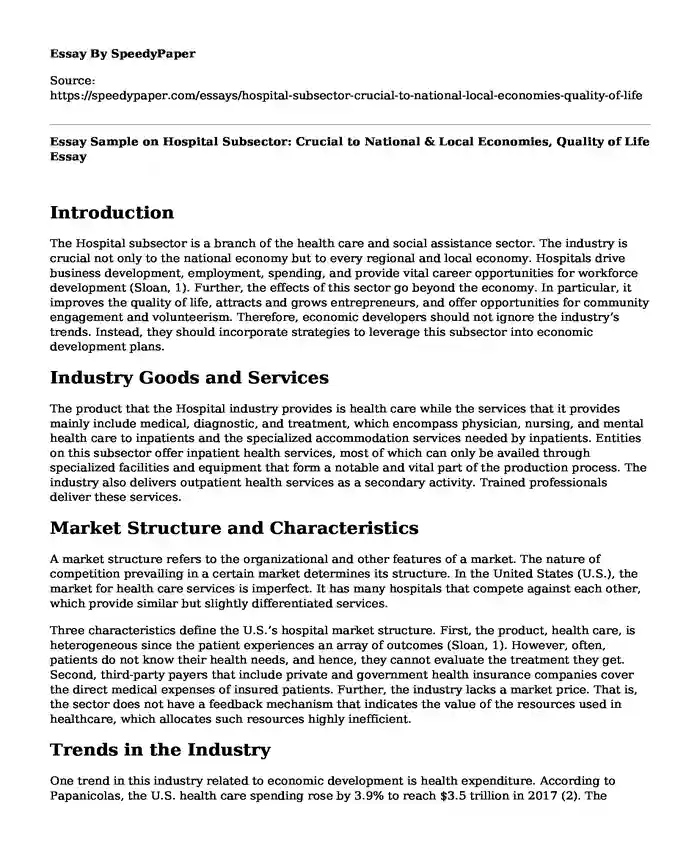
| Type of paper: | Essay |
| Categories: | Medicine Healthcare |
| Pages: | 3 |
| Wordcount: | 622 words |
Introduction
The Hospital subsector is a branch of the health care and social assistance sector. The industry is crucial not only to the national economy but to every regional and local economy. Hospitals drive business development, employment, spending, and provide vital career opportunities for workforce development (Sloan, 1). Further, the effects of this sector go beyond the economy. In particular, it improves the quality of life, attracts and grows entrepreneurs, and offer opportunities for community engagement and volunteerism. Therefore, economic developers should not ignore the industry’s trends. Instead, they should incorporate strategies to leverage this subsector into economic development plans.
Industry Goods and Services
The product that the Hospital industry provides is health care while the services that it provides mainly include medical, diagnostic, and treatment, which encompass physician, nursing, and mental health care to inpatients and the specialized accommodation services needed by inpatients. Entities on this subsector offer inpatient health services, most of which can only be availed through specialized facilities and equipment that form a notable and vital part of the production process. The industry also delivers outpatient health services as a secondary activity. Trained professionals deliver these services.
Market Structure and Characteristics
A market structure refers to the organizational and other features of a market. The nature of competition prevailing in a certain market determines its structure. In the United States (U.S.), the market for health care services is imperfect. It has many hospitals that compete against each other, which provide similar but slightly differentiated services.
Three characteristics define the U.S.’s hospital market structure. First, the product, health care, is heterogeneous since the patient experiences an array of outcomes (Sloan, 1). However, often, patients do not know their health needs, and hence, they cannot evaluate the treatment they get. Second, third-party payers that include private and government health insurance companies cover the direct medical expenses of insured patients. Further, the industry lacks a market price. That is, the sector does not have a feedback mechanism that indicates the value of the resources used in healthcare, which allocates such resources highly inefficient.
Trends in the Industry
One trend in this industry related to economic development is health expenditure. According to Papanicolas, the U.S. health care spending rose by 3.9% to reach $3.5 trillion in 2017 (2). The overall share of the country’s gross domestic product (GDP) related to this spending was 17.9%. Spending for hospital care grew by 4.6% to $1.1 trillion in 2017 (Papanicolas, 2). Certainly, this was slower than in 2016, which was attributed to a slower increase in the use and intensity of services. Mainly, hospital care spending reduced in all payers, namely private providers, Medicare, and Medicaid. However, health expenditures are expected to grow at a rate of 6.1% through 2020 to reach $4.3 trillion. The various aspects that drive this growth include the increasing aging population, advanced technology, and rising insurance coverage.
How Government Intervention May Impact the Industry
Government intervention in the health care industry is necessary and ethical. First, such intervention may affect the industry by improving the quality and safety of medical care that patients receive (Sloan, 1). For example, licensing hospitals and medical practitioners for the services they offer may control the quality of these services. Second, by providing information to the public concerning health matters may reduce the cost burden that many hospitals bear. Besides, people will take preventive measures and hence visit the emergency room less often. Consequently, medical prices may reduce significantly and raise the affordability of care. Finally, by regulating the financing of hospitals, the industry can treat all patients despite their insurance coverage.
Sources
Frank A. Sloan, 2017, Health Economics, https://books.google.co.ke/books?hl=en&lr=&id=gj3mDQAAQBAJ&oi=fnd&pg=PR5&dq=The+Economics+of+Healthcare+in+us&ots=Y9i1ygSFgq&sig=d6_9PAqEhrnfxwqdDq5tJAkv-Wc&redir_esc=y#v=onepage&q=The%20Economics%20of%20Healthcare%20in%20us&f=false
Irene Papanicolas, 2018, Health care spending in the United States and other high-income countries, https://www.oregonlegislature.gov/committees/hhc/WorkgroupDocuments/staff%20-%20(report%2005-23-2018%20meeting).pdf
Cite this page
Essay Sample on Hospital Subsector: Crucial to National & Local Economies, Quality of Life . (2023, Aug 14). Retrieved from https://speedypaper.com/essays/hospital-subsector-crucial-to-national-local-economies-quality-of-life
Request Removal
If you are the original author of this essay and no longer wish to have it published on the SpeedyPaper website, please click below to request its removal:
- Essay Example on Women's Reproductive Rights in America
- Nutrition Therapy for Diabetes, Free Essay Example
- Essay Sample Reviewing Articles about Homelessness
- Paper Example on Case Management and Health Care Reform
- Free Essay Sample - Generalized Anxiety Disorder
- Health Issues in Botswana - Free Essay Example
- Free Essay Example on Addiction Recovery Care
Popular categories




